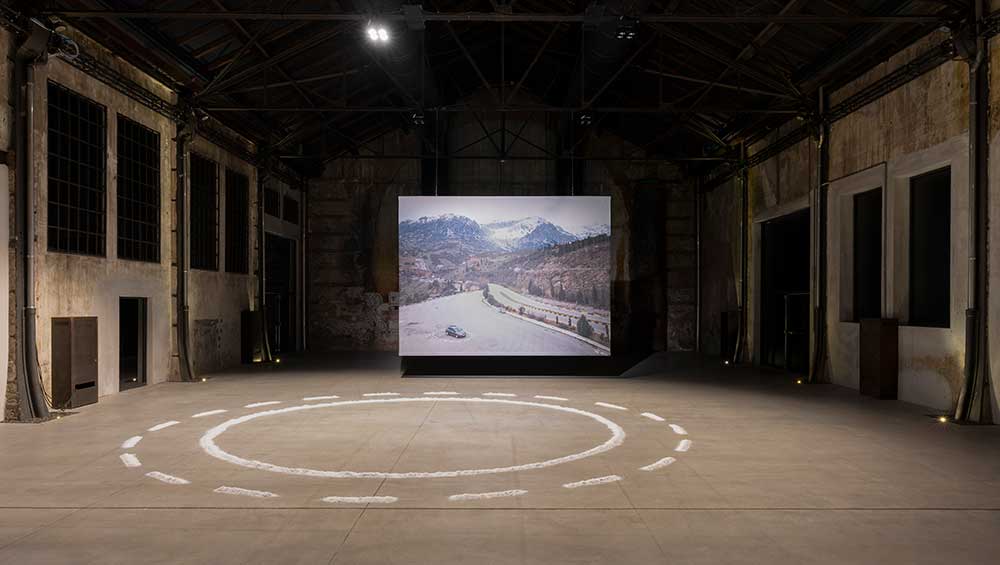
Perfect Behaviours. Life Redesigned by the Algorithm, installation view, Officine Grandi Riparazioni, Torino, 2023. Photo: Andrea Rossetti for OGR Torino.
Officine Grandi Riparazioni, Torino
29 March – 25 June 2023
by MAX L FELDMAN
Perfect Behaviours raises two vital problems. One is that we live under conditions in which what we think and feel, and how we act are shaped by algorithms. The public know little about them, and they seem to be beyond our control, so how aware are we really? The second is that we have lived through at least three decades of real political apathy, if not an outright post-ideological age. Meaningful social change requires new kinds of democratic thinking propelled by the aim of autonomy, in which the ability of individuals to decide things for themselves is intimately tied to the free decisions of everyone else. But is this possible? Taken together, these problems suggest that we are dealing with a modern difficulty in a modified context: understanding the value of human beings, which cannot be measured, under social and economic conditions in which accumulation (of profit, now of data) is an end in itself.
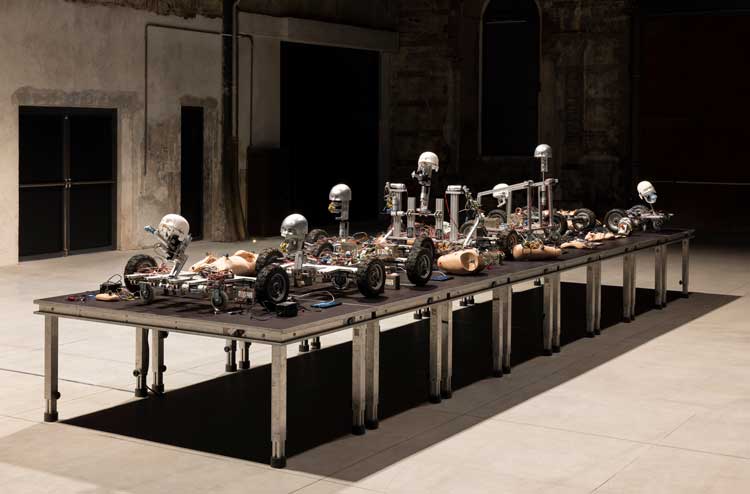
Perfect Behaviours. Life Redesigned by the Algorithm, installation view, Officine Grandi Riparazioni, Torino, 2023. Photo: Andrea Rossetti for OGR Torino.
Inspired in part by the artist and writer James Bridle’s call for “systemic literacy”, the exhibition’s curator, Giorgio Olivero, is interested in how we can develop such new reading skills. He hopes that, if we do so, it will make it possible to undercut how algorithms force us to interpret our own needs only in terms of how they function. He encourages us to do this by placing our experiences with algorithms in a wider context, showing the work of six artists – the collective Universal Everything, Paolo Cirio, Eva and Franco Mattes, Brent Watanabe, Geumhyung Jeong and Bridle – who reimagine some of the way they work and the effect they have had on us. The works are displayed in two huge, conspicuously post-industrial spaces in Turin’s former train workshop, reminding us of the old age of industry (shining steel, choking smoke and grinding physical labour) that new technologies have mostly replaced.
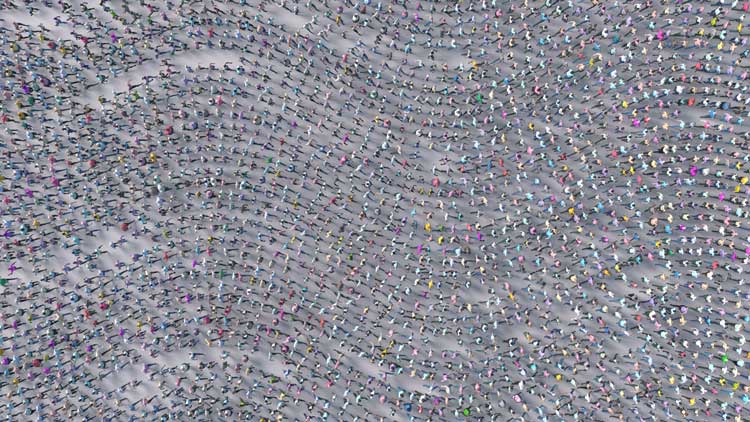
Universal Everything, Tribes, 2019. Video still. Originally commissioned by the Borusan Contemporary, Istanbul. Creative Directors: Matt Pyke, Mike Hughes. Animator: Chris Perry. Sound Designer: Simon Pyke (Freefarm). Senior Producer: Greg Povey.
Universal Everything’s five-minute video Tribes and Cirio’s installation Sociality (both 2018) respond to the problems of awareness. They show us some aspects of how algorithms and our personal electronic devices achieve new forms of what the economist André Gorz called “functional integration”:1 when what we do is determined before we make any real choices, induced by the promise of, for example, money and social status. The result is the pressure to produce measurable outcomes for someone else that are unrelated to the position we occupy in the system, and which we wouldn’t necessarily choose for ourselves, as in the machine-like conduct demanded by certain kinds of workplaces.
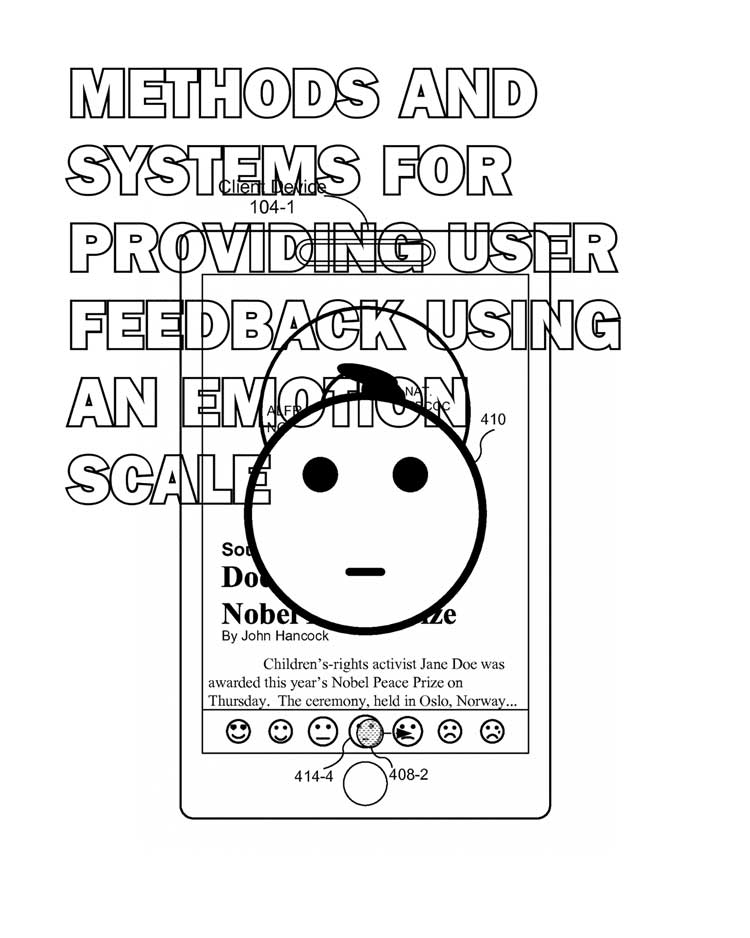
Paolo Cirio, Sociality, 2018. Digital print. Courtesy by the artist
Tribes shows how the movement of large groups of people in a predefined space (stations, stadiums, perhaps whole cities) can be managed by codes and data. Wearing different coloured jerseys, each character moves and sways in graceful patterns across the screen, like tuna under the ocean. We aren’t really watching anybody being told where to go and when. It does, however, show us that it is theoretically, and perhaps technically, possible to control population flows in ways that were once only seen in the endlessly choreographed parades and gymnastics displays of totalitarian states.
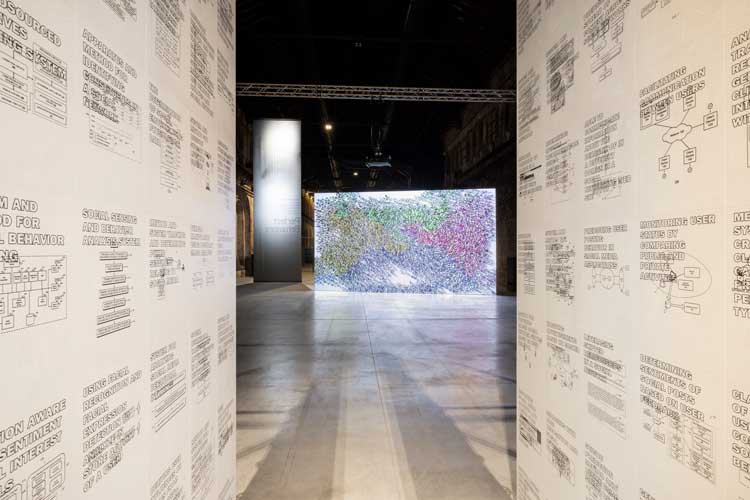
Perfect Behaviours. Life Redesigned by the Algorithm, installation view, Officine Grandi Riparazioni, Torino, 2023. Photo: Andrea Rossetti for OGR Torino.
Sociality, meanwhile, comprises a corridor consisting of two huge walls plastered with 654 black-and-white posters that reproduce plans for inventions submitted to the US Patent and Trademark Office between the late 1990s and 2018. These systems were designed to manipulate us: to make us addicted to certain products or imagined experiences; to monitor what we do at any one moment; to try to predict what we will do or buy in the future based on our habits as we use them, independently of our real objective needs. Cirio gives us a stark, dystopic reminder not only that these systems exist, or that they are making calculations about us all the time, but how we are the material that is bought and sold. We feed these systems not just with our desires for goods and services (fine clothes, delicious food and sexy titillation), but our most basic human needs (love, comfort and health).
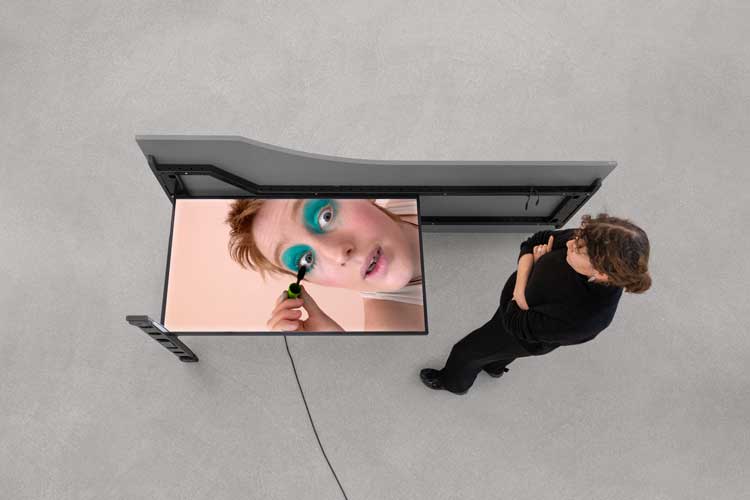
Eva & Franco Mattes, The Bots, 2020. Customized OKA desk, 55” monitor, video, headphones, various cables, 200 x 100 x h100 cm each approx. Installed at Fotomuseum Winterthur. Photo: Melania Dalle Grave and Piercarlo Quecchia for DSL Studio.
The Bots (2020) by Eva and Franco Mattes, Jeong’s Toy Prototype (2021) and Bridle’s installation Autonomous Trap 001 (2017) all raise the question of what we can do about the situation we see in Tribes and Sociality. Each work introduces a human element – a certain sort of wily cleverness in The Bots and Autonomous Trap 001, our fleshy bodily reality in Jeong – into technical systems. This shows how our humanity is not a fault that undermines the smooth operation of a system, but the vital thing that makes it work, gives it meaning, and is the ultimate purpose of and justification for all technological development.
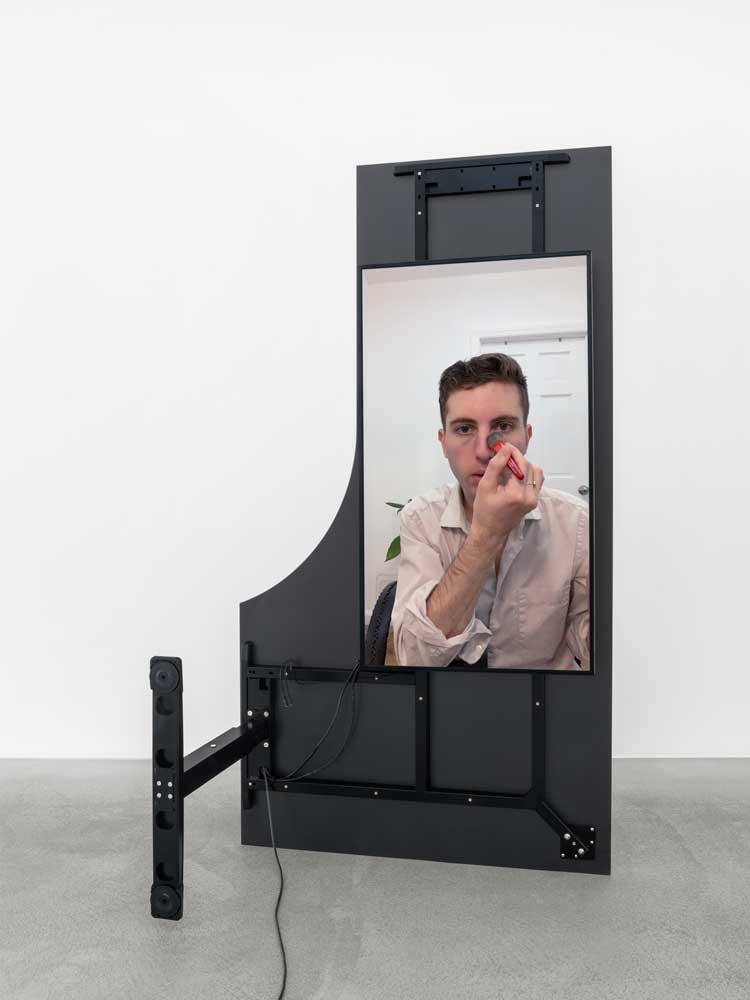
Eva & Franco Mattes, The Bots, 2020. Customized OKA desk, 55” monitor, video, headphones, various cables, 200 x 100 x h100 cm each approx. Installed at Fotomuseum Winterthur. Photo: Melania Dalle Grave and Piercarlo Quecchia for DSL Studio.
The Bots consists of six videos in which actors read the words of “human bots” Facebook pays to moderate its more appalling content. If Cirio starkly reminds us of how we are treated like machine food, The Bots shows the emotional and psychological costs of actively having to engage with systemic imperatives every day to survive. There is, however, an element of resistance here that we see again in Jeong and Bridle. Eva and Franco Mattes are inspired by and redeploy the form of amusing, cunning, algorithm-busting YouTube videos that use the conventions of makeup tutorials – the placid, even tone of someone applying foundation, blusher, contouring – to talk about politics in repressive states.
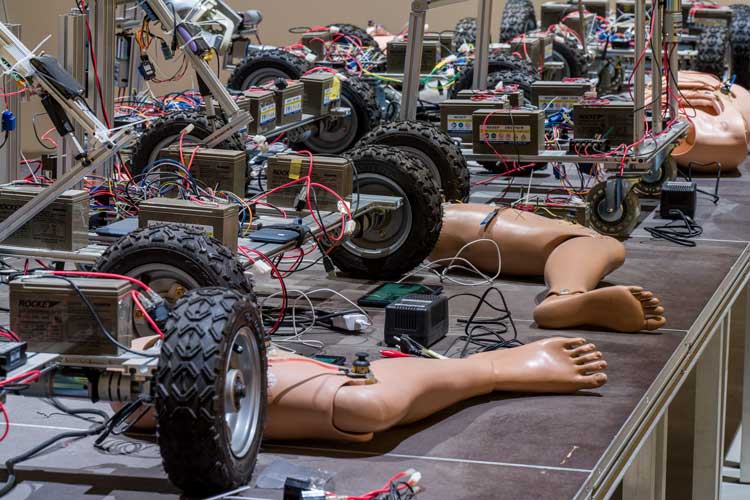
Geumhyung Jeong, Toy Prototype, 2021. Sculptures and video installation. Various materials including aluminium profiles, medical simulators, DC motors, Arduino boards, joysticks, dimensions variable. Courtesy La Biennale di Venezia.
Jeong’s Toy Prototype is a peculiar robot assemblage consisting of a series of animatronic limbs and other body parts attached to complex tributaries of wires, chassis, wheels and screens. The odd, jolting movements they end up making remind us of the all too human kinds of awkwardness that we cannot afford to forget as human bodies may become ever-more entwined with machines. Bridle’s Autonomous Trap 001 offers a similar sentiment, reproducing a magic salt circle trap to put a self-driving car to human ends (we also see this on screen behind the one on the floor of the space).
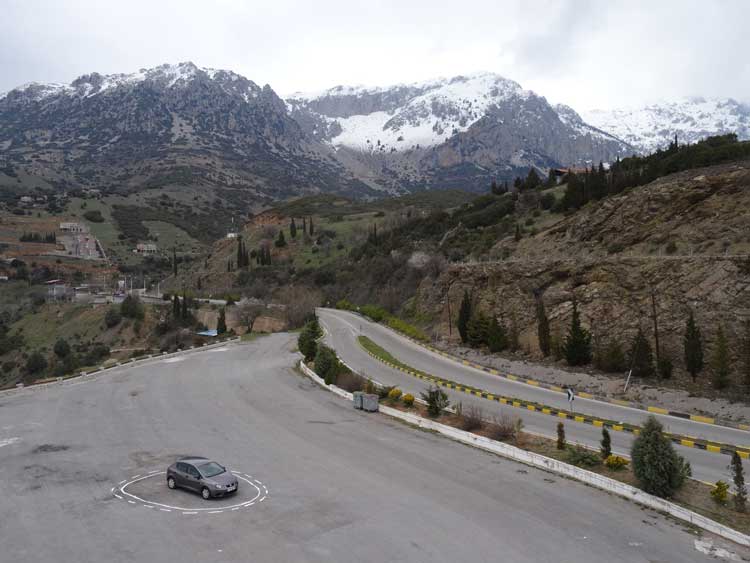
James Bridle, Autonomous Trap 001, 2017. Courtesy of the Artist.
By showing us issues relating to awareness and resistance, Watanabe’s San Andreas Streaming Deer Cam (2015-16) emphasises the “radical uncertainty” Olivero points to in his exhibition text. This piece shows an open AI plug-in for the video game Grand Theft Auto V (2013). What we see is the action being “played” by an elegant deer that comes from another piece of software and thus has an “agency” of its own. This shows how such elements – digital ones in this case, though it suggests something about human interference that positively conflicts with The Bots and Jeong – not only co-exist with non-player characters in the game (pedestrians harass it, Swat teams shoot at it), but undermine its basic workings and narrative premises.
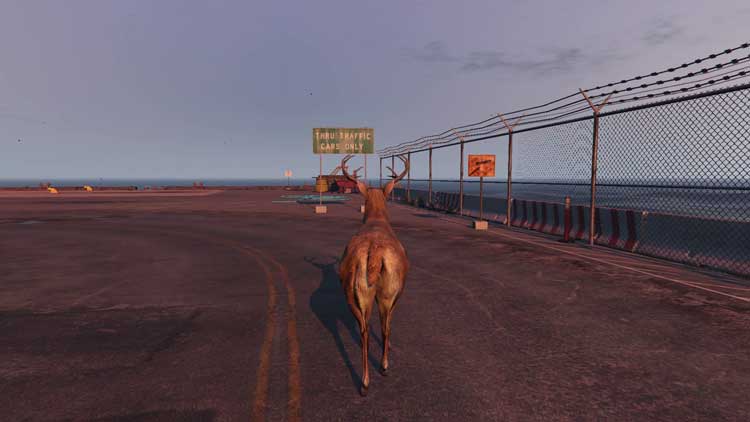
Brent Watanabe, San Andreas Streaming Deer Cam, 2015-16. © the Artist.
More than “radical uncertainty”, San Andreas Streaming Deer Cam points to the difficult task of coming to terms with a deep and troubling sense of contingency: things really do not have to be the way they appear to us and could be otherwise. The future is by no means settled; if there is widespread dissatisfaction with the current social order, then we must do something to change it. Neither the domination implied by Universal Everything (mass manipulation) and Cirio (technical control of our innermost desires) nor the emancipation intimated in Eva and Franco Mattes, Jeong and Bridle are guaranteed or even fully exclusive of each other. They depend on how we respond to the increasing technical control of reality and the social arrangements they create as they develop with the aim of making a society where everyone equally and knowingly takes part in understanding it and making it work.
Reference
1. André Gorz, Critique of Economic Reason (1988), trans. Gillian Handyside and Chris Turner, published by Verso, 1989, pp32-5.